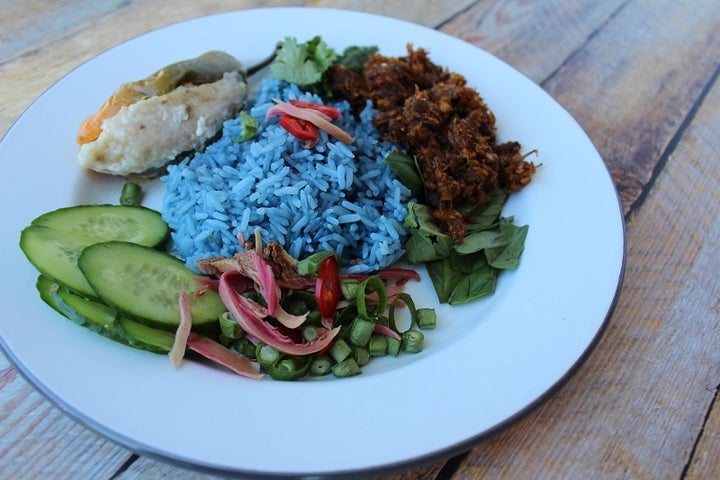I have a confession to make - I don’t spend a lot of time browsing through pretty pictures on Instagram; it’s just not how I consume content. No surprise then, that I missed the recent trend in blue butterfly (aka blue pea) flower-infused images of food and drink on social media. Apparently a clever cocktail trick is to add citrus to a blue-coloured drink and watch it magically turn purple or pink. Who knew?
When the founder of MyBlueTea.com.au sent me some sachets of natural blue butterfly flower extract in powder form, I got right down to integrating it into my Live Asian Kitchen broadcasts via traditional Malaysian recipes such as Nasi Kerabu, Onde-Onde and Kaya in, completely oblivious to the snazzy new ways Australian cafes and nightclubs are using the product.

Nasi Kerabu from my Live Asian Kitchen on Twitch
Call me old school if you like, but these live videos did stir up great excitement among my audience of overseas Malaysians because blue butterfly flower - known as bunga telang in Malaysia - was one of those ingredients that nobody really knew where to buy outside of Malaysia. Frustrated Malaysian expats could finally rejoice at the prospect of enjoying Pulut Tai Tai and Nyonya Chang without doling out for return flights to Malaysia.
The truth of the matter is, blue butterfly flower was hard to find because its use even in its native setting is relatively limited. While the Peranakans in Malaysia have been using blue flower extract since the 1500s, it remains to this day a niche product within the realm of Southeast Asian cooking.
In fact, the first time I ate Nasi Kerabu in Kuala Lumpur, the signature blue rice was actually made using artificial colouring. As it turned out, even in Malaysia, they couldn’t find fresh blue butterfly flower in a big, urban city like KL.
So why use a natural extract when you could achieve similar effects with artificial colouring? Quite simple - studies have shown that the blue butterfly flower holds antioxidant properties and is useful for memory enhancement and the treatment of a wide range of health issues from depression to weight control. It’s been widely used in Ayurvedic and Chinese medicine for centuries.
In any case, I’m all for cultural appropriation if it means, as in this instance, easy accessibility to a rare cooking ingredient thanks to increased marketplace demand. You can try to hunt down dried blue butterfly flowers in specialty stores, or you can order them online in powder form (made from 100% blue butterfly flowers) from MyBlueTea.com.au
